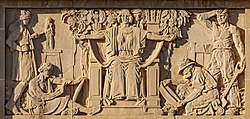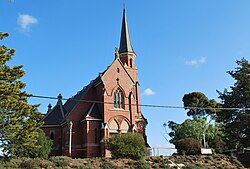| Castlemaine Victoria | |||||||||
|---|---|---|---|---|---|---|---|---|---|
|
CBD Castlemaine building, Post Office, Town Hall and the Castlemaine Uniting Church | |||||||||
| Coordinates | 37°3′49″S 144°13′2″E / 37.06361°S 144.21722°E | ||||||||
| Population | 7,506 (2021 census) | ||||||||
| Established | 1851 | ||||||||
| Postcode(s) | 3450 | ||||||||
| Elevation | 310.9 m (1,020 ft) | ||||||||
| Time zone | AEST (UTC+10) | ||||||||
| • Summer (DST) | AEST (UTC+11) | ||||||||
| Location | |||||||||
| LGA(s) | Shire of Mount Alexander | ||||||||
| State electorate(s) | Bendigo West | ||||||||
| Federal division(s) | Bendigo | ||||||||
| |||||||||
Castlemaine (/ˈkæsəlmeɪn/ KASS-əl-mayn,[1] non-locally also /ˈkɑːs-/ KAHSS-) is a town in west central Victoria, Australia, in the Goldfields region about 120 kilometres (75 miles) northwest by road from Melbourne and about 40 kilometres (25 miles) from the major provincial centre of Bendigo. It is the administrative and economic centre of the Shire of Mount Alexander. The population at the 2021 Census was 7,506.[2] Castlemaine was named by the chief goldfield commissioner, Captain W. Wright, in honour of his Irish uncle, Viscount Castlemaine.
Built on the lands of the Dja Dja Wurrung, Castlemaine began as a gold rush boomtown in 1851 and developed into a major regional centre, being officially proclaimed a City on 4 December 1965, although since declining in population.[3]
It is home to many cultural institutions including the Theatre Royal, the oldest continuously operating theatre in mainland Australia.
- ^ Macquarie Dictionary, Fourth Edition (2005). Melbourne, The Macquarie Library Pty Ltd. ISBN 1-876429-14-3.
- ^ "2021 Castlemaine, Census All persons QuickStats | Australian Bureau of Statistics". www.abs.gov.au. Retrieved 29 August 2022.
- ^ "Castlemaine" in The Age, 15 September 2008





